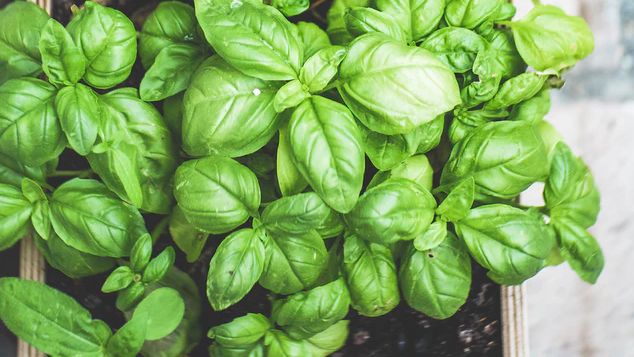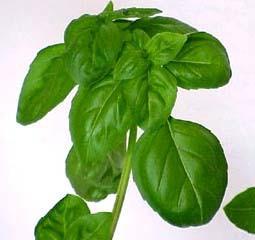How to Grow Basil in Your Garden

Summary
Basil loves warm weather, lots of sun and plenty of moisture. It prefers nutrient-rich and well-drained soils. Before planting, amend the soil with compost and fertilizer and plant after the last frost. Plant the seeds 1/8 inch deep and thin to 3 to 4 inches apart after emergence. The plants germinate in 10-14 days. Irrigate basil with about 1½ inches of water per week. To maintain rapid leaf growth, sidedress with liquid fertilizer every 14 days. When the plants have 6 to 8 leaves, harvesting can begin; remove enough of the stem so that only 2 to 4 leaves remain.
Basil Varieties
Most varieties perform well in Utah so experiment with some of the following:
Culinary Varieties
Piccolo verde fino, Red Rubin, Purple Ruffles, Lemon, Genoa Green, Napoletano, Greek, Lesbos, Ansi’, and Thai.
Other Varieties
Cinnamon, Green Ruffles, Italian Dwarf, Lemon Mrs. Burn’, Lettuce Leaf, Miniature, Mexican Spice, Sweet, and many others.
How to Grow Basil
Soils
Basil prefers fertile, well-drained loamy soils rich in organic matter. Most soils in Utah are well suited for basil production. Choose sites that have good air circulation around the plants.
Soil Preparation
Before planting, choose a site in your garden that receives full sun. Before planting, determine fertilizer needs with a soil test, then follow the recommendations given with the report. If fertilizer applications are warranted, work the fertilizer into the top 6 inches of soil. If you fertilize with compost, apply no more than 1 inch of well-composted organic matter per 100 square feet of garden area.
Plants
Basil can be grown from seed or transplants. Plant seeds or transplants after the last frost of the season. Basil seeds germinate best when soil temperatures are 75-85°F and take about 10-14 days to sprout. Transplants take 4-6 weeks to grow to size and should be planted after frosts in mid to late May.
Planting and Spacing of Basil

Sow seeds 1/8 inch deep, cover lightly with soil, and water regularly so that the soil doesn’t
dry out. Basil grown in full sun has more essential oils and better flavor than shade grown basil. After the seedlings emerge, thin to 3-4 inches apart leaving larger plants. Continue to thin the seedlings until the final plant stand is 12 inches apart. Thinned plants can be eater or transplanted to adjacent areas. Growing plants in pots on the patio is a good method to save space and get high productions. Potted plants need to be watered and feed regularly for best growth. High summer temperature and water stress causes basil to flower and set seed. Off flavors develop and plants stop leaf production.
Water
Water basil regularly supplying 1½ inches of water per week to maintain vigorous growth. Water requirements depend on soil type and temperatures. Irrigation will prevent wilting that slows growth, damages roots, and stunts plants. Drip irrigation systems can work well for watering basil plants.
Fertilization
Basil requires some additional nitrogen to sustain rapid leaf growth. When pinching plants back to produce more leaves or growing in pots, fertilize regularly with an all-purpose soluble fertilizer. Once the plants reach the harvestable stage, sidedress with organic or all-purpose liquid nitrogen sources by applying 1-2 T of fertilizer every 2-3 weeks per 10 foot of row. Fertilizer pots weekly.
Problems with Growing Basil
Weeds
Basil does not compete well with weeds so control during seedling establishment is critical. Cultivate shallowly and avoid root pruning to ensure growth is uninterrupted. Organic mulches such as grass clippings, straw and newspapers can help control weeds.
Pests and Disease
Basil is not susceptible to many production problems provided you rotate planting locations and maintain hygienic conditions near the plants.
| Insects | Identification | Control |
| Japanese Beetles and Grasshoppers | Holes eaten in the leaves. | Apply a ground treatment that kills immature insects developing underground. For adults, cover plants with garden fabric. |
| Slugs | Soft-bodied or shelled mollusks that chew holes in leaves. | Control with appropriate pesticides or traps. Avoid moist conditions that favor these pests. |
| Disease | Symptom | Control |
| Root Rot Diseases | Fungal diseases that cause decay and rotting of the roots and premature plant death. | Do not over water, practice crop rotations, and solarize the growing area. |
| Basil Shoot Blight | Fungal diseases that cause leaf spots and premature leaf loss. Dark streaks appear on stems of older plants. | Keep the plants spaced far enough apart for adequate air circulation to keep plants dry. |
How to Harvest and Store Basil
Regular leaf removal before flowers form will force the plant to grow more leaves and branches. When the plants have 6-8 leaves, harvest the leaves from the plant using a sharp knife or scissors to remove enough of the stem to leave only 2-4 leaves. Alternate the plants harvested to provide a steady supply of basil. For fresh use, cut just before use. To store fresh basil, re-cut the stems and place in a jar of water away from direct sunlight. For longer storage (7-10 days), cover the jar and stems with a plastic bag and put in the refrigerator.
Drying
Drying basil leaves for long term preservation is relatively easy. Tie the harvested stems and leaves into bunches, and hang them indoors or in a shady place to dry. Do not dry in direct sun. Leaves should dry in 5-10 days. Any non-dried leaves can be dried in an oven for 3-5 minutes at 150-200°F. Pack dried leaves in a jar with an air tight lid and store in a cool dark place. Dried basil has a shelf life of about 1 year.
Freezing
Basil leaves can be frozen, but they are mushy when thawed and don’t retain their flavor well. To retain more of the flavor, freeze whole leaves in ice cubes. Otherwise make pesto and freeze in ice cube trays. Frozen basil should be used in 3-6 months.
Productivity
Leaf production depends on the variety planted and the amount of pinching back done to the plant. ‘Genoa Green’ variety is a top foliage producer and ‘Purple Ruffles’ is a low foliage producer. Plant 5-10 plants per person for fresh use and an additional 5-10 plant for storage purposes.
Nutrition
Basil is high in vitamin E, folate, and antioxidants. Basil is low in calories, sodium and carbohydrates, and can supply dietary fiber and protein. Dried, it is much higher in all categories.
Frequently Asked Questions
Does pinching off the flowers make more leaves grow?
Pinching off the flowers as they form does not stimulate new foliage; in fact it encourages flowers to form in the axils of the leaves thus reducing the yield of the plant. Planting basil every other week and avoid stressing the plants will help keep them from flowering too quickly.
Published May 2020
Utah State University Extension
Peer-reviewed fact sheet
Download PDF
Authors
Lindsay Pearson and Dan Drost
Related Research








